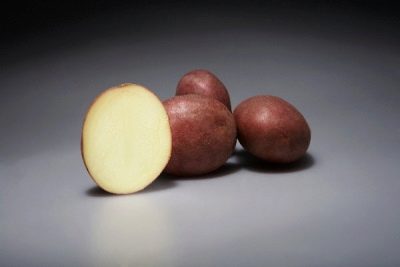
- Authors: Saatzucht Fritz Lange KG (Germany)
- Name synonyms: Alwara
- Year of approval: 1999
- Appointment: table, suitable for making French fries, chips
- Tuber weight, g: 90-104
- Peel color: red
- Color of the pulp: light yellow
- Starch content,%: 12,8-14,1%
- Tuber shape: oval
- Peel structure: smooth
Alvara potatoes belong to varieties in which the tubers are located at a convenient distance and shallow in the ground. When grown annually, it does not degenerate, even if its own material is constantly used.
Breeding history
In 1975, breeders in Germany were working on the development of Alvar's potatoes. The tubers that were used in the process have been selected for many years. The root crop that was obtained was tested before being allowed to use.
On the territory of this country, the Alvara variety was entered in the register in 1985, in Russia it appeared only in 1999.
Description of the variety
Alvara has a very high marketability, it is 81-90%. Each bush forms from 8 to 14 tubers. This potato variety can bear fruit even on not very fertile soil.
Despite the many advantages, Alvara also has a list of disadvantages. Planting tubers have a high cost, while the variety does not have sufficient immunity against phytophthora tops.
Characteristics of the appearance of the bush and root crops
The bushes of this potato variety grow tall, the tops can be erect or semi-erect. The foliage is small or medium. The shade is green, there is a slight ribbing at the edges.
The flowers are not large, rather, medium in size, a shade of red with a purple tint.
Tubers grow large, weighing from 90 to 104 grams on average. If we talk about the shape, then it is oval. The potato is red in color, with a smooth skin and eyes that go shallowly into the flesh.
Purpose and taste of tubers
Alvara potatoes have a wonderful taste and belong to culinary category B. They do not boil over, therefore they are suitable for cooking:
- French fries;
- chips;
- soups.
The root vegetable can be baked in the oven, boiled with dill, fried in a pan. In a vegetable, the percentage of starch content is from 12.8 to 14.1. This table variety lies perfectly in the cellar until spring. Alvara's keeping quality is 90%.
Maturation
Potatoes of this variety are medium early, after planting the tubers in the ground, the harvest is harvested in 90-100 days. Delayed digging up of root crops is allowed, after the tops are dry.
Yield
Alvara is ranked among high-yielding varieties, with an average index of 295 c / ha. The maximum result, which was officially recorded, is 440 c / ha. You can get a good harvest of this variety, provided that the plants are watered, fertilized and weeded on time.
Growing regions
In our country, the main regions where it is recommended to grow Alvar potatoes are the North-West and the North Caucasus, however, it is found in a much larger territory of Russia.
Growing and care
Alvar's potatoes can be grown in different ways, but the classic scheme is more often used. Before carrying out the procedure, it is necessary to properly prepare the soil, namely to free it from weeds, plow and fertilize.
Seed material is selected and germinated, then the germination of Alvara increases.To make the sprouts larger, they are laid out in a room with a temperature of 22 ° C, from time to time they are moistened from a spray bottle.
Alvara is laid out in the ground when the temperature reaches + 8 ° C. It is advised to water the area where the subsequent planting is expected in a few days.
Ash or humus can be used as a top dressing for this variety of potatoes. The distance between the rows when planting is at least 50 cm, the immersion depth of the planting material depends on the region and climatic features. Usually at least 8 cm. Every 3-4 years it is recommended for Alvara to change the site.
Watering is carried out twice a week, weeding is carried out as needed. In the Northern regions, Alvar is recommended to huddle to protect young plants from frost.
During the growth process, the potatoes are fertilized several more times. The first time feeding will be required when the tops begin to grow. Ideal for this variety is urea, bird droppings or mullein.
Wood ash and potassium sulfate are used during the budding period. The third time Alvara is fertilized when flowers appear on the bushes, it is best to use nitrophosphate during this period.

Planting potatoes is one of the main spring activities traditional for Russian gardeners. There are many ways to plant this vegetable, allowing you to get a good harvest in different conditions and climates. Before planting, you need to carefully prepare the planting material, correctly determine the timing, competently prepare the soil.



Disease and pest resistance
Alvara is genetically resistant to cancer and golden nematode. It has moderate immunity to viruses (PVX) X and (PLRV) L, as well as to late blight and black scab. For these diseases, it is better to carry out preventive treatment with fungicides.

Potatoes are a popular vegetable crop that many gardeners planted on their site. But growing a bountiful harvest of tasty and large tubers is unlikely to succeed if the beds are not properly protected from the most common diseases and pests. Often, the development of diseases of various etiologies of potatoes goes unnoticed, so it is important to identify the problem in time and eliminate it.
















































































